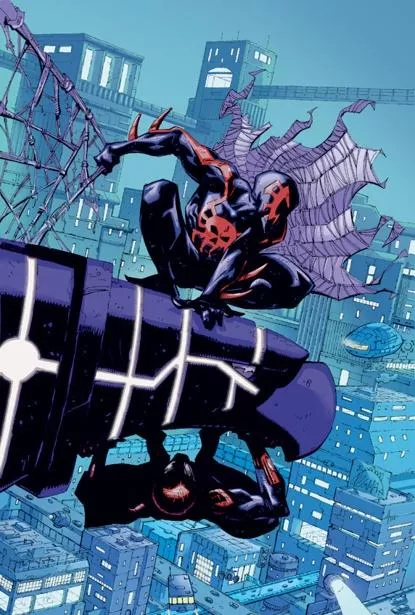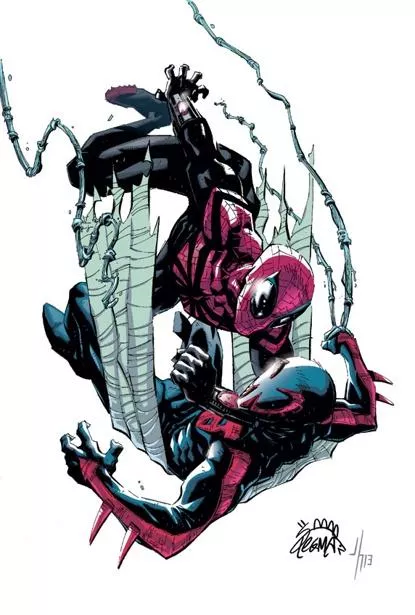In Superior Spider-Man, the creative team is offering another odd element as Spider-Man lives with the brain of Doctor Octopus. They're adding the presence of Spider-Man 2099, a hero from the future who has been a fan-favorite since his debut two decades ago. Though some may have followed the original series starring Spider-Man 2099 closely, others may wonder who this guy is or just need a refresher course on future-Spidey. Well, let's do just that and take a look at four things you should know about Spider-Man 2099.

- Marvel
1. He's a little dated - in multiple ways. Spider-Man 2099 is from the year 2099. You could have figured that one out on your own. But take a look at the character, and a different decade comes to mind. That red, tribal-like pattern that travels across his chest and down his arms and, yeah, a couple of spikes - this guy screams the 1990s. And that's because he was. The character was created by Peter David and Rick Leonardi for Marvel's original "2099" line in 1992. The world created for 2099 is your classic dystopian, corporations-run-rampant backdrop. But it was the re-envisioning of flagship characters, not the ravaged society, that made this series popular, with the first issue of Spider-Man 2099 being the highest-selling for David to date. His futuristic take on Spidey consistently sold in high numbers.
2. This isn't Peter Parker. Sure, Miguel O'Hara and Peter Parker have their similarities: They're both do-gooder New Yorkers and scientific geniuses. But O'Hara brings a few different attributes to the table. He lived with his parents growing up, but the father figure that Uncle Ben represented for Parker is a much larger presence than O'Hara's abusive dad. As an adult, O'Hara heads up a genetics program for the corporation Alchemax. Tasked with creating super soldiers, he becomes discouraged when a test subject is killed. He wants to leave the company, but things get complicated when he's conned into taking a drug called Rapture. As he tries to rid himself of the drug's hold using lab equipment, an underling rigs the machine to give him 50% spider DNA. He then sees the error of his corporate ways, and takes to crime-fighting.
3. Spider-powers are a bit different than they used to be. He has all of those familiar Spider-Man qualities: super-strength, super-agility and reflexes (but no Spider-Sense). He also has specialized vision, healing and organic webs. Talons are present on his hands and feet, which allow him to climb walls and use them as weapons. The only weird thing about those is that he has to fold them back, but at least they automatically do so when he touches his own skin. He even has fangs and glands that produce venom, which can paralyze his foes. He's creepy, which, when you think about it, is pretty fitting for someone who has the word "spider" in his or her moniker. O'Hara's costume is different than Parker's, too. His UMF (unstable molecule fabric) suit is invulnerable, and he even has the ability to glide due to pieces of the costume. All in all, he's bringing some heavy-duty power to the series, and it'll be interesting to see how he fares in the current setting.

- Marvel
4. He's been around. Though much of the 2099 universe evaporated by the mid- to late-'90s, Spider-Man 2099 has been seen in several issues here and there. But his popularity transcends mediums, with his likeness being used in a slew of video games. His costume is unlockable in games like Spider-Man: Web of Shadows, Marvel Super Hero Squad and other Spider-Man games from Activision. He was one of four protagonists in Spider-Man: Shattered Dimensions, and he was a major character in Spider-Man: Edge of Time. Spider-Man 2099 is a character that keeps returning, though many others of his class have disappeared into obscurity. Fans and, obviously, creators seem to have a certain affection for the hero. Could he end up sticking around in comics this time? That remains to be seen.
